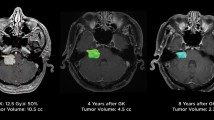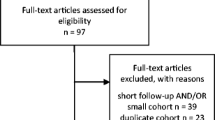Abstract
Purpose of Review
To examine and summarize the existing literature surrounding early stereotactic radiosurgery for hearing preservation in the treatment of vestibular schwannoma.
Recent Findings
There is no universally accepted definition of “early” stereotactic radiosurgery or “hearing preservation” within the vestibular schwannoma literature. Most recent studies originate from the University of Pittsburgh, where upfront stereotactic radiosurgery is routinely pursued in patients of all tumor sizes and hearing capabilities. The preliminary data suggests that short-term hearing preservation may be improved when radiating patients with smaller tumors and better hearing when compared to radiating those who present “later” in their disease course. Unfortunately, the existing literature suffers from significant limitations in study design such that proper conclusions about long-term hearing outcomes of “early” stereotactic radiosurgery and its comparison to observation or microsurgery cannot be drawn.
Summary
There is insufficient evidence in the current literature to support early stereotactic radiosurgery for hearing preservation in the treatment of vestibular schwannoma.
Similar content being viewed by others
References
Papers of particular interest, published recently, have been highlighted as: • Of major importance
Marinelli JP, Lohse CM, Carlson ML. Incidence of vestibular schwannoma over the past half-century: a population-based study of Olmsted County, Minnesota. Otolaryngology - Head and Neck Surgery (United States). 2018;159:717–23.
Kshettry VR, Hsieh JK, Ostrom QT, Kruchko C, Barnholtz-Sloan JS. Incidence of vestibular schwannomas in the United States. J Neurooncol. 2015;124:223–8.
Koo M, Lai JT, Yang EYL, Liu TC, Hwang JH. Incidence of vestibular schwannoma in Taiwan from 2001 to 2012: a population-based national health insurance study. Annals of Otology, Rhinology and Laryngology. 2018;127:694–7.
Marinelli JP, Lohse CM, Grossardt BR, Lane JI, Carlson ML. Rising incidence of sporadic vestibular schwannoma: true biological shift versus simply greater detection. Otol Neurotol. 2020;41:843–7.
Carlson ML, van Gompel JJ, Wiet RM, Tombers NM, Devaiah AK, Lal D, et al. A cross-sectional Survey of the North American Skull Base Society: current practice patterns of vestibular schwannoma evaluation and management in North America. Journal of Neurological Surgery, Part B: Skull Base. 2018;79:289–96.
Marinelli JP, Lees KA, Lohse CM, Driscoll CLW, Neff BA, Link MJ, et al. Natural history of growing sporadic vestibular schwannomas: an argument for continued observation despite documented growth in select cases. Otol Neurotol. 2020;41:e1149–53.
Tan D, Killeen DE, Kutz JW. The natural history of vestibular schwannoma and when to intervene. Curr Otorhinolaryngol Rep [Internet]. 2021;9:134–8. Available from: https://link.springer.com/10.1007/s40136-021-00337-7.
Committee on Hearing and Equilibrium Guidelines for the Evaluation of Hearing Preservation in Acoustic Neuroma (Vestibular Schwannoma): Committee on Hearing and Equilibrium. Otolaryngology–Head and Neck Surgery [Internet]. 1995;113:179–80. Available from: http://journals.sagepub.com/doi/10.1016/S0194-5998%2895%2970101-X.
Gardner G, Robertson JH. Hearing preservation in unilateral acoustic neuroma surgery. Annals of Otology, Rhinology & Laryngology [Internet]. 1988;97:55–66. Available from: http://journals.sagepub.com/doi/10.1177/000348948809700110.
Tolisano AM, Hunter JB. Hearing preservation in stereotactic radiosurgery for vestibular schwannoma. Journal of Neurological Surgery, Part B: Skull Base. 2019;80:156–64.
Gan J, Zhang Y, Wu J, Lei D, Zhang F, Zhao H, et al. Current understanding of hearing loss in sporadic vestibular schwannomas: a systematic review. Front Oncol [Internet]. 2021;11. Available from: https://www.frontiersin.org/articles/10.3389/fonc.2021.687201/full.
Celis-Aguilar E, Lassaletta L, Torres-Martín M, Rodrigues FY, Nistal M, Castresana JS, et al. The molecular biology of vestibular schwannomas and its association with hearing loss: a review. Gene Res Intern [Internet]. 2012;2012:1–10. Available from: https://www.hindawi.com/journals/gri/2012/856157/.
• Régis J, Carron R, Park MC, Soumare O, Delsanti C, Thomassin JM, et al. Wait-and-see strategy compared with proactive Gamma Knife surgery in patients with intracanalicular vestibular schwannomas. J Neurosurg. 2010;113(Suppl):105–11. This was the first manuscript to suggest early radiosurgery may be beneficial to hearing preservation.
Hunter JB, Dowling EM, Lohse CM, O’Connell BP, Tombers NM, Lees KA, et al. Hearing outcomes in conservatively managed vestibular schwannoma patients with serviceable hearing. Otol Neurotol [Internet]. 2018;39:e704–11. Available from: http://www.ncbi.nlm.nih.gov/pubmed/30036205.
Reznitsky M, Cayé-Thomasen P. Systematic review of hearing preservation in observed vestibular schwannoma. Journal of Neurological Surgery, Part B: Skull Base. 2019;80:165–8.
Yomo S, Carron R, Thomassin JM, Roche PEH, Régis J. Longitudinal analysis of hearing before and after radiosurgery for vestibular schwannoma. J Neurosurg. 2012;117:877–85.
Watanabe S, Yamamoto M, Kawabe T, Koiso T, Yamamoto T, Matsumura A, et al. Stereotactic radiosurgery for vestibular schwannomas: average 10-year follow-up results focusing on long-term hearing preservation. J Neurosurg. 2016;125:64–72.
Akpinar B, Mousavi SH, McDowell MM, Niranjan A, Faraji AH, Flickinger JC, et al. Early radiosurgery improves hearing preservation in vestibular schwannoma patients with normal hearing at the time of diagnosis. Intern J Rad Oncol Biol Phys [Internet]. Elsevier Inc. 2016;95:729–34. Available from: https://doi.org/10.1016/j.ijrobp.2016.01.019.
• Johnson S, Kano H, Faramand A, Niranjan A, Flickinger JC, Dade LL. Predicting hearing outcomes before primary radiosurgery for vestibular schwannomas. J Neurosurg. 2020;133:1235–41. This manuscript is interesting as they provide a scoring rubric to identify patients who might be ideal candidates to receive radio surgery early in their disease course.
• Ogino A, Long H, Johnson S, Faramand A, Niranjan A, Flickinger JC, et al. Useful hearing preservation is improved in vestibular schwannoma patients who undergo stereotactic radiosurgery before further hearing deterioration ensues. J Neuro-Oncol [Internet]. Springer US; 2021;152:559–66. Available from: https://doi.org/10.1007/s11060-021-03726-6. This paper indirectly suggests that patients who receive radiosurgery prior to hearing deterioration may have short term benefits to hearing preservation.
Ogino A, Lunsford LD, Long H, Johnson S, Faramand A, Niranjan A, et al. Stereotactic radiosurgery as the first-line treatment for intracanalicular vestibular schwannomas. J Neurosurg. 2021;135:1051–7.
Funding
None.
Author information
Authors and Affiliations
Corresponding author
Ethics declarations
Conflict of Interest
The authors have no relevant financial or non-financial interests to disclose.
Human and Animal Rights and Informed Consent
This article does not contain any studies with human or animal subjects performed by any of the authors.
Additional information
Publisher's Note
Springer Nature remains neutral with regard to jurisdictional claims in published maps and institutional affiliations.
This article is part of the Topical collection on Otology
Rights and permissions
Springer Nature or its licensor holds exclusive rights to this article under a publishing agreement with the author(s) or other rightsholder(s); author self-archiving of the accepted manuscript version of this article is solely governed by the terms of such publishing agreement and applicable law.
About this article
Cite this article
Tan, D., Hunter, J.B. Early Gamma Knife Radiosurgery for Hearing Preservation in Vestibular Schwannoma. Curr Otorhinolaryngol Rep 10, 365–369 (2022). https://doi.org/10.1007/s40136-022-00423-4
Accepted:
Published:
Issue Date:
DOI: https://doi.org/10.1007/s40136-022-00423-4




